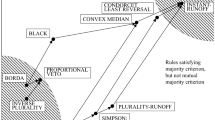Abstract
In market based societies consumers are able to express the intensity of their preference for an object by paying more for it. However, under some voting systems, consumers are unable to express the intensity of their preference for a candidate due to the constraint of the “one person, one vote” principle. Cumulative voting maintains the equality of the “one person, one vote” principle by allotting each voter the same number of votes, while also allowing for expression of intensity of candidate preference. This paper provides an experimental analysis of voter behavior under different voting systems.
Similar content being viewed by others
References
Amy, D. (2000). Behind the ballot box: a citizen’s guide to voting systems. Westport: Praeger.
Cooper, D. (2002). Development of a proximity spatial model of cumulative voting. Working Paper, Morehouse College.
Cooper, D. (2005). Quantifying fairness to individual voters in multimember versus single-member districts. Working Paper, Morehouse College.
Cooper, D. (2007). The potential of cumulative voting to yield fair representation. Journal of Theoretical Politics, 19, 277–295.
Cox, G. (1990). Centripetal and centrifugal incentives in electoral systems. American Journal of Political Science, 34, 903–935.
Felsenthal, D. (1985). Is cumulative voting really different from one-man, one-vote? Electoral Studies, 4, 141–148.
Fischbacher, U. (2007). z-Tree Zurich toolbox for readymade economic experiments. Experimental Economics, 10, 171–178.
Gerber, E., Morton, R., & Rietz, T. (1998). Minority representation in multi-member districts. American Political Science Review, 92, 127–144.
Glasser, G. J. (1959). Game theory and cumulative voting for corporate directors. Management Science, 5, 151–156.
Goldburg, C. (1994). The accuracy of game theory predictions for political behavior: cumulative voting in Illinois revisited. The Journal of Politics, 56, 714–719.
Guinier, L. (1994). The tyranny of the majority: fundamental fairness in representative democracy. New York: Free Press.
Kuklinski, J. (1974). Cumulative and plurality voting: an analysis of Illinois’ unique electoral system. Western Political Quarterly, 26, 726–746.
Pothoff, R.F., & Brams, S.J. (1998). Proportional representation: broadening the options. Journal of Theoretical Politics 10, 147–178.
Radcliff, B. (1993). The structure of voter preferences. Journal of Politics, 55, 714–719.
Sass, T., & Mehay, S. (2003). Minority representation, election method, and policy influence. Economics and Politics, 15, 323–339.
Sawyer, J., & MacRae, D. (1962). Game theory and cumulative voting in Illinois: 1902–1954. American Political Science Review, 56, 936–946.
Tabarrok, A. (2001). President Perot or fundamentals of voting theory illustrated with the 1992 election. Public Choice, 106, 275–297.
Author information
Authors and Affiliations
Corresponding author
Rights and permissions
About this article
Cite this article
Cooper, D., Zillante, A. A comparison of cumulative voting and generalized plurality voting. Public Choice 150, 363–383 (2012). https://doi.org/10.1007/s11127-010-9707-5
Received:
Accepted:
Published:
Issue Date:
DOI: https://doi.org/10.1007/s11127-010-9707-5




